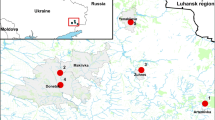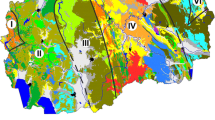Abstract
The lack of information on the atmospheric pollution by various chemical elements in the areas of oil and gas exploitation creates a necessity for the study of natural ecosystems in these territories. In the Tomsk region (Western Siberia, Russia), we have implemented a method of atmospheric motoring using biomonitors. The aim of this research is to estimate the environmental state in oil field exploitation areas of the Tomsk region using epiphytic lichens and sphagnum mosses. The plant ash was analyzed by instrumental neutron activation analysis for the quantitative definition of 28 chemical elements. The study showed that lichens accumulate Sc, Br, Ce, Sn, Eu, Tb, La, Lu, Th, and U in larger amounts, while the mosses accumulate Rb, Ag, Cs, Ba, and Au. Concentrations of Na, Ca, Cr, Fe, Co, Zn, As, Sr, Sb, Yb, Hf, and Ta in the studied samples are approximately the same. In comparison with the mean values of chemical elements in mosses and lichens of Western Siberia and other northern regions, the studied territory has higher concentrations of Cr, Fe, Zn, Sb, Sc, Sr, Yb, Hf, and U. These features can be caused both by the influence of local sources of atmospheric pollution in oil field exploitation areas, and geochemical, geographical, and climatic peculiarities of the studied territory.




Similar content being viewed by others
References
Aubert D, Le Roux G, Krachler M, Cheburkin A (2006) Origin and fluxes of atmospheric REE entering an ombrotrophic peat bog in Black Forest (SW Germany): evidence from snow, lichens and mosses. Geochim Cosmochim Acta 70:2815–2826
Babeshina LG (2011) Sphagnum mosses of Western Siberian plane: morphology, anatomy, ecology and application in medicine (in Russian: Sfagnovye mhi Zapadno-Sibirskoj ravniny: morfologija, anatomija, jekologija i primenenie v medicine). Dissertation, Tomsk State University
Baranovskaya NV (2011) Regularities of accumulation and distribution of chemical elements in organisms of natural and natural-anthropogenic ecosystems (in Russian: Zakonomernosti nakoplenija i raspredelenija himicheskih jelementov v organizmah prirodnyh i prirodno-antropogennyh jekosistem). Dissertation, Tomsk Polytechnic University
Bargagli R (1998) Trace elements in terrestrial plants an ecophysiological approach to biomonitoring and biorecovery. Springer, Berlin
Bargagli R, Mikhailova I (2002) Accumulation of inorganic contaminants. In: Nimis PL, Scheidegger C, Wolseley PA (eds) Monitoring with lichens: monitoring lichens. Kluwer Academic Publishers, Berlin, pp 65–84
Chakrabortty Sh, Paratkar GT (2006) Biomonitoring of trace element air pollution using mosses. Aerosol Air Qual Res 6(3):247–258
Colbeck I, Lazaridis M (2010) Aerosols and environmental pollution. Die Naturwissenschaften 97(2):17–31
Dragović S, Mihailović N (2009) Analysis of mosses and topsoils for detecting sources of heavy metal pollution: multivariate and enrichment factor analysis. Environ Monit Assess 157:383–390
Fiedler S, Siebe C, Herre A, Roth B, Cram S, Stahr K (2009) Contribution of oil industry activities to environmental loads of heavy metals in the Tabasco Lowlands, Mexico. Water Air Soil Pollut 197:35–47
Govindapyari H, Leleeka M, Nivedita M, Uniyal PL (2010) Bryophytes: indicators and monitoring agents of pollution. NeBIO 1(1):35–41
Le Roux G, Pinelli E, Hedde M, Guiresse M, Vleeschouwer F, Silvestre J, Enrico M, Gandois L, Monna F, Gers CH, Probst A (2013) Biogeochemistry of antimony, sources, transfers, impacts and assessment. In: Geophysical research abstracts 15, EGU general assembly 2013, held 7–12 April 2013 in Vienna, Austria, id EGU2013-7487
Markert BA, Breure AM, Zechmeister HG (eds) (2003) Bioindicators and biomonitors: principles, concepts, and applications. Elsevier, Amsterdam
Mezhibor AM (2009) Ecogeochemistry of trace elements in upland peat of Tomsk region (in Russian: Jekogeohimija jelementov-primesej v verhovyh torfah Tomskoj oblasti). Dissertation, Tomsk Polytechnic University
Mezhibor AM, Arbuzov SI, Arkhipov VS (2013) Trace elements in peat bogs of Tomsk region (South Siberia, Russia). Energy Explor Exploit 31(4):629–644
Moskovchenko DV (2006) Biogeochemical features of upland bogs in West Siberia (In Russian: biogeohimicheskie osobennosti verhovyh bolot Zapadnoj Sibiri). Geografija i prirodnye resursy 1:63–67
Palmieri F, Neri R, Benco C, Serracca L (1997) Lichens and moss as bioindicators and bioaccumulators in air pollution monitoring. J Environ Pathol Toxicol Oncol 16(2–3):175–190
Reimann C, de Caritat P (1998) Chemical elements in the environment. Factsheets for the geochemists and environmental scientists. Springer, Berlin-Heidelberg
Shevchenko VP, Filippov DA, Gordeev VV, Demina LL (2011) Contents of heavy metals in sphagnum moss of Vologodsk region (in Russian: Soderzhanie tjazhelyh metallov v sfagnovyh mhah Vologodskoj oblasti). Sovremennye problemy nauki i obrazovanija 14:1–8
Strahovenko VD, Shherbov BL, Hozhina EI (2005) Distribution of radionuclides and trace elements in lichens in various regions of West Siberia (in Russian: Raspredelenie radionuklidov i mikrojelementov v lishajnikovom pokrove razlichnyh regionov Zapadnoj Sibiri). Geologija i geofizika 46(2):206–216
Syso AI (2007) Regularities of the distribution of chemical elements in soil-forming rocks and soils of Western Siberia. Institute of Soil Science and Agrochemistry, Novosibirsk
Tretiach M, Adamo P, Bargagli R, Baruffo L, Carletti L, Crisafulli P, Giordano S, Modenesi P, Orlando S, Pittao E (2007) Lichen and moss bags as monitoring devices in urban areas. Part I: influence of exposure on sample vitality. Environ Pollut 146:380–391
Tschan M, Robinson BH, Schulin R (2009) Antimony in the soil–plant system: a review. Environ Chem 6:106–115
Valeeva EI, Moskovchenko DV (2002) Trace-element composition of lichens as an indicator of atmospheric pollution in Northern West Siberia. Polar Geogr 26(4):249–269
Wolterbeek HT, Garty J, Reis MA, Freitas MC (2002) Biomonitors in use: lichens and metal air pollution. In: Markert BA (ed) Trace metals and other contaminants in the environment bioindicators and biomonitors: Principles, concepts and applications. Elsevier, Amsterdam, pp 377–419
Acknowledgments
We thank our colleagues from JSC “TomskNIPIneft” for their help in sampling. The work is supported by the program of National Research Tomsk Polytechnic University No. VI_132_2014. The work was also funded within the framework of realization of Strategic Program on National Research Tomsk Polytechnic University Competitiveness Enhancement in the Group of Top Level World Research and Academic Institutions.
Author information
Authors and Affiliations
Corresponding author
Rights and permissions
About this article
Cite this article
Mezhibor, A.M., Bolshunova, T.S. & Rikhvanov, L.P. Geochemical features of sphagnum mosses and epiphytic lichens in oil and gas exploitation areas (the case of Western Siberia, Russia). Environ Earth Sci 75, 1260 (2016). https://doi.org/10.1007/s12665-016-6062-y
Received:
Accepted:
Published:
DOI: https://doi.org/10.1007/s12665-016-6062-y




